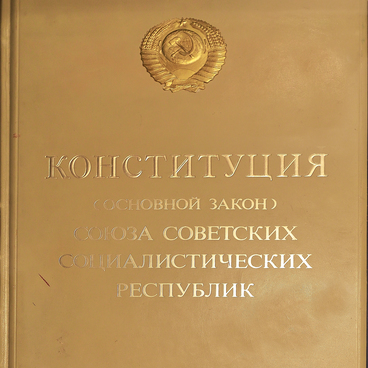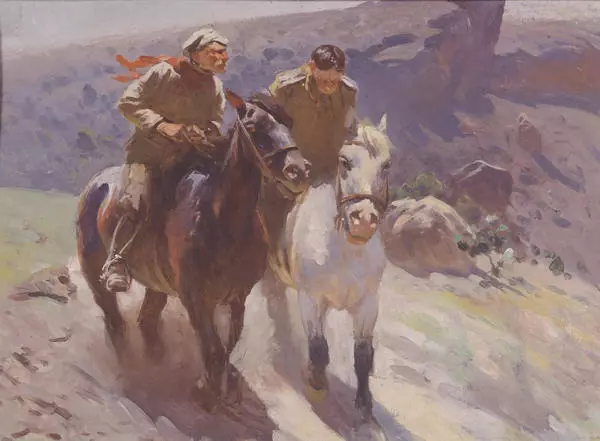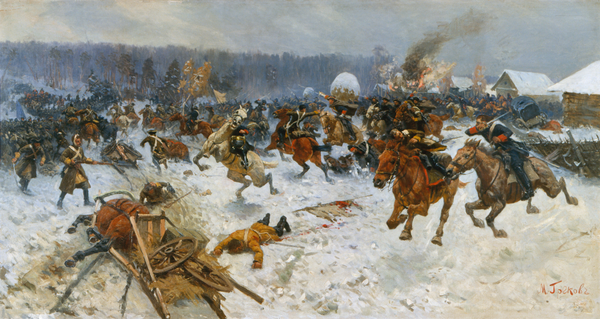Mitrofan Grekov was born in 1882 on the Don. He studied at the Odessa Art School, and later entered the Academy of Arts. Grekov was a student of Ilya Repin, but the greatest influence was exerted on him by another teacher, the battle artist Franz Roubaud.
The main subject of Grekov’s artwork was the Civil War. The artist went through the First World War on the German front, and in 1920 joined the Red Army as a volunteer. During the war, he took sketches and drew propaganda posters.
Grekov’s canvases are based on his own impressions and personal experience rather than on the historical sources, archival materials or literary descriptions. A distinctive feature of his paintings was intense action. Fierce hand-to-hand combat, an avalanche of soldiers entering the city, the Red cavalry galloping through a snow-covered field and other vivid images created by the painter did not leave contemporaries indifferent. Modern scholars consider Grekov one of the founders of the Soviet battle painting.
Permanent exhibition of the museum presents Grekov’s painting The Kornilovists. Kornilovists were units of the White armies who fought in the South of Russia during the Civil War. They received patronage of Lavr Kornilov, the four-star infantry general.
Lavr Kornilov was born in 1870. He received a brilliant education, having graduated from the Siberian Cadet Corps, Mikhailovsky Artillery School and the Nikolaev Academy of the General Staff with a gold medal. After completion of his training, he joined the Army and participated in the battles of the First World War. Soon after the February Revolution, Kornilov became Supreme Commander-in-Chief and achieved success on this post.
Over time, the general became an active participant in the domestic political struggle. Kornilov was not happy with the Provisional Government, in particular with Alexander Kerensky who was very timid in taking important decisions given the growing crisis in the country. In September 1917, Kornilov rebelled and moved his troops to Petrograd. In response, Kerensky dismissed the general from his post and declared him a rebel, but Kornilov refused to surrender to the authorities.
The riot was suppressed, and Kornilov was taken into custody. In December, he was released and left for Novocherkassk, where he joined one of the White Guard units, and in January became commander of the Volunteer Army. Kornilov and his detachments crossed the Don and in February 1918 they moved forward to the Kuban.
General Kornilov was killed on 13 April 1918 by a shell explosion during the assault on the city of Yekaterinodar (Krasnodar).
The main subject of Grekov’s artwork was the Civil War. The artist went through the First World War on the German front, and in 1920 joined the Red Army as a volunteer. During the war, he took sketches and drew propaganda posters.
Grekov’s canvases are based on his own impressions and personal experience rather than on the historical sources, archival materials or literary descriptions. A distinctive feature of his paintings was intense action. Fierce hand-to-hand combat, an avalanche of soldiers entering the city, the Red cavalry galloping through a snow-covered field and other vivid images created by the painter did not leave contemporaries indifferent. Modern scholars consider Grekov one of the founders of the Soviet battle painting.
Permanent exhibition of the museum presents Grekov’s painting The Kornilovists. Kornilovists were units of the White armies who fought in the South of Russia during the Civil War. They received patronage of Lavr Kornilov, the four-star infantry general.
Lavr Kornilov was born in 1870. He received a brilliant education, having graduated from the Siberian Cadet Corps, Mikhailovsky Artillery School and the Nikolaev Academy of the General Staff with a gold medal. After completion of his training, he joined the Army and participated in the battles of the First World War. Soon after the February Revolution, Kornilov became Supreme Commander-in-Chief and achieved success on this post.
Over time, the general became an active participant in the domestic political struggle. Kornilov was not happy with the Provisional Government, in particular with Alexander Kerensky who was very timid in taking important decisions given the growing crisis in the country. In September 1917, Kornilov rebelled and moved his troops to Petrograd. In response, Kerensky dismissed the general from his post and declared him a rebel, but Kornilov refused to surrender to the authorities.
The riot was suppressed, and Kornilov was taken into custody. In December, he was released and left for Novocherkassk, where he joined one of the White Guard units, and in January became commander of the Volunteer Army. Kornilov and his detachments crossed the Don and in February 1918 they moved forward to the Kuban.
General Kornilov was killed on 13 April 1918 by a shell explosion during the assault on the city of Yekaterinodar (Krasnodar).





